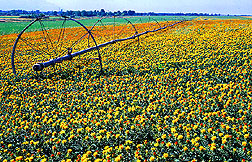This page has been archived and is being provided for reference purposes only. The page is no longer being updated, and therefore, links on the page may be invalid.
Rotating Safflower with Wheat Can Boost Farmers' ProfitsBy Dawn Lyons-JohnsonApril 15, 1998 Safflower's vibrant yellow petals catch the eye, but it's the deep-growing roots of this oilseed crop that farmers may find most attractive. Agricultural Research Service scientists at Mandan, N.D., say wheat farmers on the western Great Plains can grow safflower (Carthamus tinctorius L.) as a high-value rotation crop. ARS scientists Donald Tanaka and Steve Merrill say safflower's deep roots take up water and nutrients that wheat can't reach. Wheat plant roots grow about four feet deep, while safflower's roots push down to six feet. Safflower also thrives in the warm, dry summer climate of the western Great Plains. The scientists found that safflower is well suited to no-till wheat fields because the seeds can be planted close to the surface. It germinates and takes advantage of the high moisture content of no-till, where little or no tillage preserves organic matter. Safflower has been cultivated in the United States since the 1950s. Safflower seeds are processed for cooking oil or sold for higher-quality bird food. Rotating safflower with wheat will increase acreage and allow farmers to sell the seed for these high-value uses. Planting safflower also has an environmental benefit: ARS research shows up to 50 percent less nitrates in soil during years when safflower was planted in rotation with wheat. Nitrate is another form of nitrogen, an important crop fertilizer. By using safflower in a crop rotation, farmers can prevent nitrates from leaching into the groundwater because the safflower plants take up nitrogen and use it to produce the seeds, Tanaka says. A complete story on safflower and its benefits as a rotational crop in wheat can be found in the April issue of Agricultural Research magazine. The article is also on the World Wide Web at: /is/AR/archive/apr98/saff0498.htm Scientific contact: Donald Tanaka and Steve Merrill, Natural Resources Management Research unit, Northern Great Plains Research Laboratory, Mandan, ND, phone (701) 667-3063/3016, fax (701) 667-3054, tanakad@manda.ars.usda.gov, MerrillS@mandan.ars.usda.gov. |

